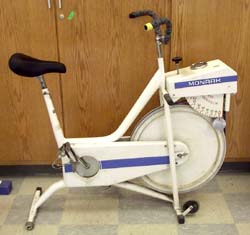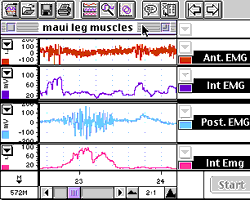| This cycle ergometer allows you to pedal against various loads (resistance). A metronome helps to keep a steady rhythm. |
 |
| You can walk or run on the treadmill at different speeds. The treadmill can be inclined up to 12% to simulate walking uphill and you can prop up the back to simulate walking downhill. |
 |
| A set of hand weights (1, 2, 3, 5, 10, 20 lbs) can be used to study the effects of muscle loading on the EMG. |
 |
| This red LED can be driven by a 5 V pulse from the square wave stimulator and its activity displayed on the computer. Use this if you want a visual stimulus for a study of reaction time. (For an audible stimulus, you can use the percussion hammer from the last lab to bang on something.) |
 |
| Another useful tool for reaction time studies is this foot pedal, simulating the brake pedal on a car. When depressed, it sends a 1.5 V pulse to the computer. |
 |
| You can configure the data acquisition system to accept inputs from up to 4 external sources, plus 4 more channels of computed input. This group recorded raw and integrated EMGs from two muscles simultaneously plus an event recorder (hand switch). Click on the picture for a larger view in a new window. |
 |
| This electronic thermocouple thermometer is handy for any study involving measurement of skin temperature. |
 |
| BBRRRRR!!! If you want to examine the effect of temperature on nerve conduction velocity or reaction time, you can use this special water bath, supplemented by ice packs or hot water packs on the thigh. It takes a lengthy immersion for the temperature of the nerve to be changed. |
 |